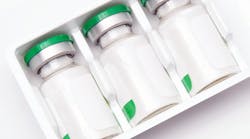When it comes to manufacturing health-giving and life-saving pharmaceutical products, the No. 1 goal is to protect valuable payloads. The right thermal packaging solution is critical to maintaining the efficacy of temperature-sensitive vaccines, biologics, blood supplies, tissues and more. But choosing the right temperature-controlled packaging is more complex than payload size and temperature requirements. The ever-changing nature of the supply chain plays an important role.
Over the past two years, COVID-19 and its impacts on transportation significantly disrupted supply chains. Companies were forced to reassess nearly everything, including their cold chain logistics. One area of focus: choosing between single-use packaging or reusable temperature-controlled packaging.
Based on best practices and today’s economic environment, here are the criteria companies should consider when deciding which type of packaging is best.
Performance
Historically, single-use thermal packaging was made with extruded polystyrene (EPS) or polyurethane (PUR) insulation and gel pack heat sinks that provided temperature control for shorter durations and decreased payload space. Pharma companies with high-value products and long shipping durations would choose reusable packaging for its ability to maintain temperature control and for volumetric efficiency.
But today’s single-use packaging now includes phase change material (PCM) and vacuum insulated panels (VIPs) like reusable systems, so there is less of a performance difference between the two types of packaging.
Companies that do evaluate packaging based on performance typically look at durability and the ability to monitor temperatures in transit. Reusable packaging is more sturdy and able to withstand rugged conditions. It also allows companies to use reusable data loggers or temperature recording devices with high-value products or on challenging shipping lanes. Some companies also select reusable packaging for longer shipping durations, though some single-use shippers can provide comparable performance.
Questions to consider:
- Is your payload fragile or high-value?
- Is it important to use a temperature monitoring device or data logger?
- Are any of your shipping lanes challenging with a significant risk for temperature excursions?
- Does the company you’re working with have quality processes for refurbishment and conditioning of reusable packaging? Do they follow Good Manufacturing Practices and have necessary certifications?
Cost
The hypercompetitive and unforgiving biopharma landscape demands that organizations achieve consistency and control without eating into margins. Increasing cost pressures lead organizations to take a closer look at defining total cost in their logistics and supply chain operations.
At the most basic level, pharma companies compare the price of single-use shippers and the per-use cost of a reusable shipper. However, other factors impact the total cost. For single-use shippers, companies must consider real estate required to store inventory. This cost could also include housing, running and maintaining conditioning equipment, as well as staff and training expenses.
One large biopharma company customer was experiencing extensive labor in conditioning and assembly of single-use solutions, which resulted in limited payload performance protection from excursions. The company used active systems for longer international lanes and emerging markets, and the rental costs had a significant financial impact on product and distribution budgets.
The customer switched to a reusable pallet-accepting shipper to eliminate onsite conditioning and assembly labor, which provided significant cost savings. The most notable key performance indicators were an increase in warehouse real estate by eliminating dedicated space for conditioning or warehousing of components, and reduction in labor times for assembly and pack out.
Cold chain companies recently began offering pre-conditioning and just-in-time packaging for reusable temperature-controlled packaging. Although not available from all cold chain packaging companies, some now also offer the same service for single-use packaging to help pharma companies conserve valuable real estate and eliminate barriers to picking the right packaging option for their business. Additionally, these services set the stage for pharma companies to fully outsource their cold chain operations — a growing trend in the pharma industry.
Another factor to consider for reusable packaging is the cost to buy versus pay-per-use. Buying shares similar advantages and disadvantages to single-use shippers, specifically inventory storage, staffing and training. Pay-per-use can alleviate all three of these requirements by allowing companies to fully outsource their cold chain operations.
When using reusable shippers, reverse logistics is also critical. There are costs associated with returning a shipper, and inventory not returned is money lost on the unreturned product and an additional cost to purchase a new shipper.
Questions to consider:
- How frequently do you ship products that require a similar size shipper?
- What is the cost of a single-use shipper vs. the per-use cost of a reusable shipper?
- How many trips would it take to make a reusable shipper cost less per trip?
- What is the cost of reverse logistics for your shipping lanes? Are your receiving locations set up to return shippers?
- Do you have warehouse space to store owned reusable packages? Do you have trained staff dedicated to cold chain logistics?
Transport
In today’s economic environment, transportation has a more pronounced impact on the decision about which type of temperature-controlled packaging to use. In early October 2021, a record number of container ships were sitting off the West Coast of the United States waiting to dock. Each ship carries thousands of containers — space that is currently unavailable for moving other products around the world.
In the early days of the COVID-19 pandemic, pharma companies began switching from reusable to single-use packaging out of sanitization concerns. Now many companies use single-use packaging as a risk-mitigation strategy. While companies ship high-value pharmaceutical products by air freight, reusable packaging often returns by less costly sea freight internationally and ground freight domestically. Today that process could take months, leaving companies without reusable inventory when they need it most.
Additionally, the backup of shipping containers and lack of truck drivers means demand for shipping space is higher than supply, causing an increase in shipping costs. Although reverse logistics is slightly easier domestically, moving packaging internationally is challenging and expensive.
Outside of the pandemic, shipping lanes can impact the decision on which type of thermal packaging to use. Some countries have onerous import and export requirements or customs challenges that impact reverse logistics. This is particularly true for some countries in the Middle East and Latin America. Single-use packaging could also make sense when the frequency of shipments to a location is low.
Questions to consider:
- Are current shipping challenges impacting your ability to receive shipments?
- Does the current cost of shipping change the per-use cost of a reusable shipper?
- How does that compare to the cost of a single-use shipper?
- Are the countries you ship to set up to accommodate reverse logistics?
- How frequently do you ship to the same location?
- Does your cold chain company have service centers in locations near your departure and destination locations?
Sustainability
According to the Peli BioThermal 2020 Biopharma Cold Chain Logistics Sustainability Survey, the biopharma industry is increasing its pace to prioritize sustainability in business and operational strategies. Nearly half of all respondents say that they always factor sustainability into cold chain purchasing decisions, and 53% indicate that it is very important to choose cold chain packaging options that advance their organization’s sustainability goals.
Recyclability and lower emissions matter to pharma companies. Greater focus is being put on how cold chain packaging is constructed, with increasingly high value placed on cold chain packaging that is recyclable or can more easily enter the waste stream. Likewise, the industry leans toward lighter, more energy-efficient shippers that reduce carbon emissions for temperature-sensitive pharma products being shipped by air.
Traditionally, companies have used single-use thermal containers made with EPS or PUR insulation and gel pack heat sinks to ship temperature-sensitive pharmaceuticals. Throughout a two-year clinical trial, companies would make an average of 30,000 individual package shipments and emit 1,122 tons of CO2e with this approach. A two-year clinical trial using a reusable product in this example would require only 772 units and 241 tons of CO2e. This is a 78% difference in global warming potential between the single-use and reusable approaches.
Similar differences exist in other impact categories with the reusable approach including 56% less human toxicity potential and 95% less post-consumer waste. The cradle-to-gate emissions of a single-use container are the overwhelming cause of its high environmental burden since it requires manufacturing and using more units. Additionally, the reusable container in this example is about half the weight of the average single-use container, which lowers its transportation impact below the single-use approach emissions despite an extra leg of travel needed to return reusable containers.
The same biopharma company mentioned earlier also saw an impact on its sustainability goals by moving from single-use to reusable shippers. Consignees were no longer burdened with disposal challenges, and the elimination of waste in landfills made a significant impact on the environment.
The environmental break-even point between the two logistical approaches occurs after as few as six shipments. This outcome suggests that a reusable approach is environmentally preferable for any organization that utilizes large shipping volumes that require thermal control.
Questions to consider:
- What are your sustainability goals?
- What impact do your cold chain operations have on these goals?
- Do you ship a high volume of temperature-sensitive products?
- Do your end-users have set sustainability goals or expectations for their suppliers?
- Does your cold chain company use recyclable materials and have stated sustainability goals?
Choosing the right thermal packaging is not a one-size-fits-all approach. Both single-use and reusable packaging are necessary — the real goal is to have the right tool in the toolbelt at the right time.






